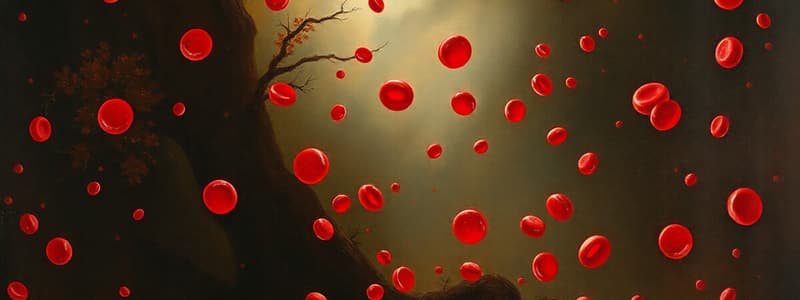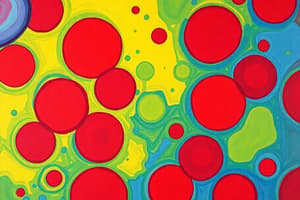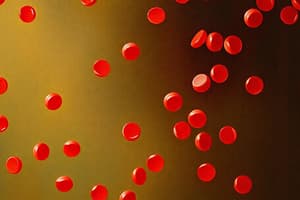Podcast
Questions and Answers
What is the primary mechanism of excessive bleeding in thrombocytopenia?
What is the primary mechanism of excessive bleeding in thrombocytopenia?
- Excessive platelet consumption in thrombi formation
- Increased platelet destruction by antibodies (correct)
- Impaired platelet function due to genetic defects
- Decreased platelet production in the bone marrow
Which of the following conditions is NOT a contributing factor to thrombocytopenia?
Which of the following conditions is NOT a contributing factor to thrombocytopenia?
- Massive blood transfusions
- Portal hypertension
- Increased platelet production (correct)
- Splenomegaly
What is the typical time frame for relief from bleeding in thrombocytopenia after fresh whole blood transfusion?
What is the typical time frame for relief from bleeding in thrombocytopenia after fresh whole blood transfusion?
- More than 4 weeks
- 1-4 weeks
- 1-4 hours
- 1-4 days (correct)
What is the primary reason for splenectomy in thrombocytopenia?
What is the primary reason for splenectomy in thrombocytopenia?
What is the most important component of Factor VIII for intrinsic pathway clotting?
What is the most important component of Factor VIII for intrinsic pathway clotting?
What is the term for an abnormal clot that develops within a blood vessel?
What is the term for an abnormal clot that develops within a blood vessel?
What is the major difference between a thrombus and an embolus?
What is the major difference between a thrombus and an embolus?
Which of these can be used to treat thromboembolic conditions?
Which of these can be used to treat thromboembolic conditions?
What is the primary function of fibrin fibers in blood clotting?
What is the primary function of fibrin fibers in blood clotting?
Which of the following is NOT a characteristic of the extrinsic pathway of blood clotting?
Which of the following is NOT a characteristic of the extrinsic pathway of blood clotting?
What happens to the thrombin that does not adsorb to fibrin fibers during clotting?
What happens to the thrombin that does not adsorb to fibrin fibers during clotting?
What is the role of heparin in blood clotting?
What is the role of heparin in blood clotting?
How does plasminogen contribute to dissolving blood clots?
How does plasminogen contribute to dissolving blood clots?
Which of the following factors DOES NOT directly contribute to the speed of the extrinsic pathway of blood clotting?
Which of the following factors DOES NOT directly contribute to the speed of the extrinsic pathway of blood clotting?
Which factor is directly activated by factor XII?
Which factor is directly activated by factor XII?
What is the role of platelet phospholipids in the clotting process?
What is the role of platelet phospholipids in the clotting process?
What is the main mechanism by which antithrombin III inhibits thrombin?
What is the main mechanism by which antithrombin III inhibits thrombin?
Which of the following is NOT a direct consequence of blood trauma or contact with collagen?
Which of the following is NOT a direct consequence of blood trauma or contact with collagen?
What is the significance of the observation that approximately 85% to 90% of thrombin becomes adsorbed to fibrin fibers during clot formation?
What is the significance of the observation that approximately 85% to 90% of thrombin becomes adsorbed to fibrin fibers during clot formation?
What is the primary role of activated Factor X in the clotting cascade?
What is the primary role of activated Factor X in the clotting cascade?
Which factor is described as a vehicle that accelerates the conversion of prothrombin to thrombin?
Which factor is described as a vehicle that accelerates the conversion of prothrombin to thrombin?
What is the role of thrombin in the intrinsic pathway of coagulation?
What is the role of thrombin in the intrinsic pathway of coagulation?
Which step in the intrinsic pathway is dependent on the presence of calcium ions?
Which step in the intrinsic pathway is dependent on the presence of calcium ions?
Which of the following statements accurately describes the intrinsic pathway of coagulation?
Which of the following statements accurately describes the intrinsic pathway of coagulation?
Which of the following molecules plays a role in both the intrinsic and extrinsic pathways of coagulation?
Which of the following molecules plays a role in both the intrinsic and extrinsic pathways of coagulation?
What is the significance of the positive feedback effect of thrombin in the clotting cascade?
What is the significance of the positive feedback effect of thrombin in the clotting cascade?
How long does bleeding typically last when a sharp-pointed knife pierces the tip of the finger or earlobe during the coagulation test?
How long does bleeding typically last when a sharp-pointed knife pierces the tip of the finger or earlobe during the coagulation test?
What is the primary reason blood collected in siliconized containers often does not clot for an extended period?
What is the primary reason blood collected in siliconized containers often does not clot for an extended period?
What is the normal clotting time when blood is collected in a chemically clean glass test tube?
What is the normal clotting time when blood is collected in a chemically clean glass test tube?
Which factor most notably prolongs bleeding time when absent?
Which factor most notably prolongs bleeding time when absent?
In surgical procedures, what anticoagulant is primarily utilized to prevent coagulation?
In surgical procedures, what anticoagulant is primarily utilized to prevent coagulation?
Why is the use of heparin for measuring clotting time limited in many clinics?
Why is the use of heparin for measuring clotting time limited in many clinics?
What is the typical method for determining clotting time using a glass test tube?
What is the typical method for determining clotting time using a glass test tube?
Which factor is least likely to delay blood coagulation when outside the body?
Which factor is least likely to delay blood coagulation when outside the body?
What is the typical prothrombin time measured in seconds?
What is the typical prothrombin time measured in seconds?
What is the purpose of the international normalized ratio (INR) in clinical practice?
What is the purpose of the international normalized ratio (INR) in clinical practice?
Which of the following factors can influence the variability of prothrombin time results?
Which of the following factors can influence the variability of prothrombin time results?
What may differ in isolated tissue factor from human tissues?
What may differ in isolated tissue factor from human tissues?
In what year was the antithrombotic therapy for peripheral artery disease discussed?
In what year was the antithrombotic therapy for peripheral artery disease discussed?
Which of the following statements is true regarding prothrombin time assay results?
Which of the following statements is true regarding prothrombin time assay results?
What is a potential source for isolating tissue factor?
What is a potential source for isolating tissue factor?
What aspect of prothrombin time testing may cause discrepancies in results?
What aspect of prothrombin time testing may cause discrepancies in results?
What is the primary function of platelets in hemostasis?
What is the primary function of platelets in hemostasis?
Which of the following is NOT a mechanism involved in vascular constriction during hemostasis?
Which of the following is NOT a mechanism involved in vascular constriction during hemostasis?
What is the normal concentration of platelets in the blood?
What is the normal concentration of platelets in the blood?
What is the function of thrombosthenin in platelets?
What is the function of thrombosthenin in platelets?
Which of the following does NOT contribute to the contraction of the smooth muscle surrounding a ruptured blood vessel?
Which of the following does NOT contribute to the contraction of the smooth muscle surrounding a ruptured blood vessel?
What is the function of the enzyme systems within platelets that synthesize prostaglandins?
What is the function of the enzyme systems within platelets that synthesize prostaglandins?
What is the role of the actin and myosin molecules in platelets?
What is the role of the actin and myosin molecules in platelets?
Which of the following is NOT a step in the process of hemostasis?
Which of the following is NOT a step in the process of hemostasis?
Flashcards
Hemostasis
Hemostasis
The process to prevent blood loss when blood vessels are severed or ruptured.
Platelet Concentration
Platelet Concentration
Normal concentration of platelets in blood is 150,000 to 450,000/µl.
Vascular Constriction
Vascular Constriction
The immediate contraction of blood vessel smooth muscle after injury to reduce blood flow.
Platelet Plug Formation
Platelet Plug Formation
Signup and view all the flashcards
Blood Coagulation
Blood Coagulation
Signup and view all the flashcards
Fibrous Tissue Growth
Fibrous Tissue Growth
Signup and view all the flashcards
Contractile Proteins in Platelets
Contractile Proteins in Platelets
Signup and view all the flashcards
Local Autacoid Factors
Local Autacoid Factors
Signup and view all the flashcards
Antithrombin III
Antithrombin III
Signup and view all the flashcards
Intrinsic Pathway
Intrinsic Pathway
Signup and view all the flashcards
Extrinsic Pathway
Extrinsic Pathway
Signup and view all the flashcards
Heparin
Heparin
Signup and view all the flashcards
Thrombin
Thrombin
Signup and view all the flashcards
Fibrin Fibers
Fibrin Fibers
Signup and view all the flashcards
Plasminogen
Plasminogen
Signup and view all the flashcards
Contact Activation
Contact Activation
Signup and view all the flashcards
Activated Factor X
Activated Factor X
Signup and view all the flashcards
Prothrombin
Prothrombin
Signup and view all the flashcards
Platelet Phospholipids
Platelet Phospholipids
Signup and view all the flashcards
Activated Factor V
Activated Factor V
Signup and view all the flashcards
Smart Activation Pathway
Smart Activation Pathway
Signup and view all the flashcards
Activated Factor XI
Activated Factor XI
Signup and view all the flashcards
Calcium Ions (Ca2+)
Calcium Ions (Ca2+)
Signup and view all the flashcards
Positive Feedback in Clotting
Positive Feedback in Clotting
Signup and view all the flashcards
Thrombocytopenia
Thrombocytopenia
Signup and view all the flashcards
Antibodies in Thrombocytopenia
Antibodies in Thrombocytopenia
Signup and view all the flashcards
Factor VIII Components
Factor VIII Components
Signup and view all the flashcards
Classic Hemophilia
Classic Hemophilia
Signup and view all the flashcards
Fresh Whole Blood Transfusion
Fresh Whole Blood Transfusion
Signup and view all the flashcards
Splenectomy
Splenectomy
Signup and view all the flashcards
Disseminated Intravascular Coagulation (DIC)
Disseminated Intravascular Coagulation (DIC)
Signup and view all the flashcards
Bleeding Duration
Bleeding Duration
Signup and view all the flashcards
Clotting Factor Deficiency
Clotting Factor Deficiency
Signup and view all the flashcards
Clotting Time
Clotting Time
Signup and view all the flashcards
Siliconized Containers
Siliconized Containers
Signup and view all the flashcards
Heparin Use
Heparin Use
Signup and view all the flashcards
Intrinsic Clotting Mechanism
Intrinsic Clotting Mechanism
Signup and view all the flashcards
Glass Test Tube Method
Glass Test Tube Method
Signup and view all the flashcards
Clotting Measurement Variability
Clotting Measurement Variability
Signup and view all the flashcards
Prothrombin Time
Prothrombin Time
Signup and view all the flashcards
Prothrombin Concentration
Prothrombin Concentration
Signup and view all the flashcards
International Normalized Ratio (INR)
International Normalized Ratio (INR)
Signup and view all the flashcards
Tissue Factor
Tissue Factor
Signup and view all the flashcards
Analytical System Variation
Analytical System Variation
Signup and view all the flashcards
Coagulation Factors
Coagulation Factors
Signup and view all the flashcards
Bleeding Disorders
Bleeding Disorders
Signup and view all the flashcards
Fibrinogen's Role
Fibrinogen's Role
Signup and view all the flashcards
Study Notes
Hemostasis and Blood Coagulation
- Hemostasis is the prevention of blood loss
- It occurs through several mechanisms: vascular constriction, platelet plug formation, blood clot formation, and fibrous tissue growth.
Vascular Constriction
- Immediate trauma to a vessel wall causes smooth muscle contraction, reducing blood flow.
- Local myogenic spasm, local factors from tissues/blood vessels/platelets, and nervous reflexes cause contraction.
- Thromboxane A2, released by platelets, causes vasoconstriction, especially in smaller vessels.
- The severity of trauma correlates directly with the degree of vascular spasm.
Platelet Plug Formation
- Platelets/thrombocytes are small discs (1-4 µm) formed in bone marrow from megakaryocytes.
- Normal platelet count is 150,000-450,000/µL.
- Platelets lack nuclei and cannot reproduce.
- Platelets contain actin, myosin, and thrombosthenin (contractile proteins), residuals of the endoplasmic reticulum and Golgi apparatus, mitochondria, enzyme systems for ATP/ADP production, enzymes for prostaglandin synthesis, fibrin-stabilizing factor, and a growth factor.
- Platelet surface glycoproteins repel normal endothelium adhesion, but adhere to injured areas, especially exposed collagen.
- Platelets have a short lifespan (8-12 days).
- Platelet activation occurs when exposed to damaged vessel wall (collagen). This changes platelet shape, promotes the release of granules (ADP, PAF, thromboxane A2), makes them sticky, allowing them to adhere to sites of injury and each other.
- These platelets form a loose plug, which is strengthened by fibrin threads during blood coagulation.
Blood Coagulation
- Blood clotting is initiated by activator substances (from damaged tissues, platelets, and blood proteins).
- Blood clot formation takes 15-20 seconds for severe trauma and 1-2 minutes for minor trauma.
- Clotting factors (listed in Table 37-1) are involved in a complex cascade of chemical reactions.
- Prothrombin activator catalyzes the conversion of prothrombin to thrombin.
- Thrombin converts fibrinogen to fibrin fibers. These fibers reinforce the loose platelet plug, forming a stable clot.
Mechanism of Platelet Plug Formation
- Platelet adhesion: platelets adhere to exposed collagen and von Willebrand factor (vWF)
- Platelet activation: shape change, granule release (ADP, thromboxane A2), and increased stickiness
- Platelet aggregation: activated platelets aggregate (clump together) to form a plug.
- Fibrin reinforcement: strengthens the plug, forming a solid clot.
Blood Clot Dissolution
- Fibrous organization: fibroblasts invade the clot, forming connective tissue.
- Dissolution: clots can dissolve through activation of substances that break down the clot.
Blood Coagulation Mechanisms
- Extrinsic pathway: initiated by tissue trauma, involving tissue factor and factor VII.
- Intrinsic pathway: initiated by blood trauma or exposure to collagen. Involves factors XII, XI, IX, and VIII.
- Both pathways converge at factor X activation, leading to the formation of prothrombin activator which then converts prothrombin to thrombin, and fibrinogen to fibrin, forming the blood clot.
Intravascular Anticoagulants
- Endothelial surface factors prevent contact activation of the intrinsic clotting system.
- Glycocalyx repels clotting factors and platelets.
- Thrombomodulin binds thrombin and activates protein C, which is an anticoagulant.
- Prostacyclin and nitric oxide inhibit platelet aggregation and are produced by intact endothelial cells.
Positive Feedback in Clot Formation
- Thrombin's proteolytic actions activate other clotting factors, accelerating clot formation, leading to a positive feedback loop.
Conditions for Excessive Bleeding in Humans
- Vitamin K Deficiency: reduced production of clotting factors (prothrombin, factor VII, IX, and X).
- Hemophilia: genetic defects in clotting factors VIII or IX preventing proper clotting.
- Thrombocytopenia: low platelet count leading to spontaneous bleeding and bruising.
Blood Coagulation Tests
- Bleeding Time: measures time it takes for bleeding to stop after a small puncture.
- Clotting Time: measures the time it takes for blood to clot in a test tube.
- Prothrombin Time (PT) / International Normalized Ratio (INR): assess the extrinsic pathway and measures the time it takes for a clot to form in plasma with tissue factor.
Prevention of Blood Coagulation Outside the Body
- Silicone surfaces prevent contact activation of clotting factors.
- Heparin interferes with the conversion of prothrombin to thrombin.
Studying That Suits You
Use AI to generate personalized quizzes and flashcards to suit your learning preferences.




